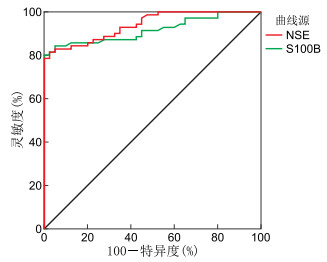Expression and significance of serum NSE and S100B protein during different degrees of neonatal asphyxia
-
摘要:
目的 新生儿窒息为新生儿时期的常见病,早期正确诊断对于治疗至关重要,本文主要研究神经元特异性烯醇化酶(neuron specific enolase, NSE)和中枢神经特异性蛋白B(S100B protein)在不同程度窒息新生儿血清中的表达,并探讨其对新生儿窒息的诊断价值。 方法 选取2018年12月—2020年4月因出生窒息入住蚌埠医学院第一附属医院NICU的新生儿70例为窒息组,根据出生时Apgar评分分为2组:轻度窒息组(40例)和重度窒息组(30例)。正常对照组选取同期健康新生儿40例。检测各组新生儿生后24 h内及窒息组新生儿治疗7 d后的血清NSE、S100B水平。 结果 轻度窒息组和重度窒息组血清NSE、S100B水平较对照组明显升高(均P < 0.05);重度窒息组血清NSE、S100B水平较轻度窒息组明显升高(均P < 0.05)。治疗后,轻度窒息组和重度窒息组血清NSE、S100B水平均明显降低(均P < 0.05)。血清NSE对新生儿窒息预测的灵敏度为81.43%,特异度为97.50%,AUC为0.939。血清S100B对新生儿窒息预测的灵敏度为80.00%,特异度为100.00%,AUC为0.916。 结论 血清NSE和S100B可作为诊断新生儿窒息的重要依据,对临床上评估新生儿窒息程度具有一定参考价值。 -
关键词:
- 新生儿窒息 /
- 神经元特异性烯醇化酶 /
- 中枢神经特异性蛋白B /
- Apgar评分
Abstract:Objective Neonatal asphyxia is a common disease during the neonatal period. Early and correct diagnosis of this disease is very important for treatment. This study investigated the expression of neuron-specific enolase (NSE) and central nervous system-specific protein B (S100B protein) in the serum of newborns with different degrees of asphyxia. This study examined whether these proteins can be used as indicators in the diagnosis of neonatal asphyxia. Methods Seventy newborns admitted to the NICU of the First Affiliated Hospital of Bengbu Medical College from December 2018 to April 2020 were selected and assigned to the asphyxia group. Then according to the Apgar(appearance, pulse, grimace, activity, and respiration) score at birth, the they were again divided into mild asphyxia group (n=40) and severe asphyxia group (n=30). 40 healthy newborns were selected as the normal control group, during the same period. The Levels of serum NSE and S100B were measured within 24 h after birth in each group and 7 days after treatment in the asphyxia group. Results The levels of serum NSE and S100B in the mild asphyxia and severe asphyxia groups were significantly higher than those in the control group. The levels of serum NSE and S100B in the severe asphyxia group were significantly higher than those in the mild asphyxia group (all P < 0.05). After the treatment, the levels of serum NSE and S100B in the mild asphyxia and severe asphyxia groups significantly decreased (all P < 0.05). The sensitivity and specificity of serum NSE to the prediction of neonatal asphyxia were 81.43% and 97.50%, respectively. The area under the receiver operating characteristic curve (AUC) was 0.939. By comparison, the sensitivity and specificity of serum S100B to the prediction of neonatal asphyxia were 80.00% and 100.00%, respectively. The AUC curve was 0.916. Conclusion Both serum NSE and S100B can be used as an important basis for the diagnosis of neonatal asphyxia and have a certain reference value for clinical evaluation of the degree of neonatal asphyxia. -
Key words:
- Neonatal asphyxia /
- Neuron-specific enolase /
- S100B /
- Apgascore
-
表 1 新生儿窒息危险因素的单因素分析结果[M(P25, P75)]
组别 例数 性别(男/女, 例) 分娩方式(顺产/剖宫产, 例) 胎龄(周) 出生体重(kg) NSE(ng/mL) S100B(ng/L) 对照组 40 21/19 24/16 39.0(38.0, 40.0) 3.27(3.01, 3.60) 12.84(10.23, 16.09) 315.50(254.00, 381.25) 窒息组 70 34/36 31/39 39.2(38.4, 40.0) 3.20(2.90, 3.61) 35.65(22.56, 56.20) 861.00(471.00, 1 393.00) 统计量 0.157a 2.514a -1.537b -0.768b -7.640b -7.239b P值 0.692 0.113 0.124 0.443 < 0.001 < 0.001 注:a为χ2值,b为Z值。 表 2 新生儿窒息危险因素的多因素分析结果
项目 B SE Wald χ2 P值 OR值 95% CI NSE 0.275 0.088 9.703 0.002 1.317 1.107~1.566 S100B 0.015 0.006 5.986 0.014 1.015 1.003~1.028 表 3 各组新生儿血清NSE、S100B水平比较[M(P25, P75)]
组别 例数 NSE(ng/mL) S100B(ng/L) 对照组 40 12.84(10.23, 16.09) 315.50(254.00, 381.25) 轻度窒息组 40 31.71(21.12, 40.27)a 812.50(422.75, 1 077.50)a 重度窒息组 30 41.06(28.50, 55.58)ab 1 335.00(510.50, 2 630.00)ab H值 60.008 55.162 P值 < 0.001 < 0.001 注:与对照组比较,aP < 0.05;与轻度窒息组比较,bP < 0.05。 表 4 2组窒息新生儿治疗前后血清NSE、S100B水平比较[M(P25, P75)]
组别 例数 NSE(ng/mL) Z值 P值 S100B(ng/L) Z值 P值 治疗前 治疗后 治疗前 治疗后 轻度窒息组 40 31.71(21.12, 40.27) 12.88(10.30, 15.20) -5.471 < 0.001 812.50(422.75, 1 077.50) 306.00(253.25, 338.50) -5.317 < 0.001 重度窒息组 30 41.06(28.50, 55.58) 15.97(13.80, 18.40) -4.597 < 0.001 1 335.00(510.50, 2 630.00) 360.00(294.00, 429.75) -4.350 < 0.001 -
[1] 邵肖梅, 叶鸿瑁, 丘小汕. 实用新生儿学[M]. 4版. 北京: 人民卫生出版社, 2014: 271-273. [2] 顾海红, 俞丽君, 张豪, 等. 持续新生儿复苏培训对新生儿窒息和病死率的影响[J]. 中华全科医学, 2016, 14(9): 1512-1515. https://www.cnki.com.cn/Article/CJFDTOTAL-SYQY201609028.htm [3] 陈自励. 从循证角度审视新生儿窒息诊断和分度标准[J]. 中国当代儿科杂志, 2019, 21(1): 1-5. https://www.cnki.com.cn/Article/CJFDTOTAL-DDKZ201901002.htm [4] 虞人杰, 王俊怡, 刘淑芳, 等. "新生儿窒息多器官损害的临床诊断标准"解读[J]. 中华围产医学杂志, 2016, 19(4): 243-246. doi: 10.3760/cma.j.issn.1007-9408.2016.04.002 [5] RAKESH K, VISHNU BHAT B, ADHISIVAM B, et al. Effect of therapeutic hypothermia on myocardial dysfunction in term neonates with perinatal asphyxia-a randomized controlled trial[J]. J Matern Fetal Neonatal Med, 2018, 31(18): 2418-2423. doi: 10.1080/14767058.2017.1344633 [6] 张定芬, 陈志辉, 梁春杰. 新生儿窒息与血乳酸和心肌酶水平的关系[J]. 海南医学, 2017, 28(24): 4027-4028. doi: 10.3969/j.issn.1003-6350.2017.24.022 [7] 胡亚美, 江载芳. 诸福棠实用儿科学[M]. 8版. 北京: 人民卫生出版社, 2015: 450-451. [8] 全国新生儿窒息多器官损害临床诊断多中心研究协作组. 新生儿脐动脉血气分析在新生儿窒息多器官损害诊断中的应用[J]. 中国新生儿科杂志, 2016, 31(2): 91-96. https://www.cnki.com.cn/Article/CJFDTOTAL-QQHB201816005.htm [9] 中华医学会围产医学会新生儿复苏组. 新生儿窒息诊断的专家共识[J]. 中华围产医学杂志, 2016, 19(1): 3-6. doi: 10.3760/cma.j.issn.1007-9408.2016.01.002 [10] 武士敏, 张洁, 美丽班·哈盼, 等. 脐动脉血TNF-α、HMGB1及NSE检测在新生儿窒息中的变化及其意义[J]. 中国医师杂志, 2017, 19(7): 1094-1097. doi: 10.3760/cma.j.issn.1008-1372.2017.07.043 [11] 罗厚江, 汪瑞, 陈茹茹, 等. 动脉血乳酸水平与早期乳酸清除率在新生儿窒息严重程度判断及预后评估中的价值[J]. 中华全科医学, 2019, 17(9): 1536-1538. https://www.cnki.com.cn/Article/CJFDTOTAL-SYQY201909030.htm [12] 陈俊国, 吴鸣, 张旭, 等. 轻度胃肠炎伴婴幼儿良性惊厥患儿脑脊液中S100B蛋白、MBP、NSE变化的相关性研究[J]. 中华全科医学, 2017, 15(6): 986-988. https://www.cnki.com.cn/Article/CJFDTOTAL-SYQY201706025.htm [13] 臧丽娇, 仇杰, 庄根苗, 等. 血清S100B蛋白、神经元特异性烯醇化酶与新生儿低血糖脑损伤的相关性[J]. 山东大学学报(医学版), 2016, 54(4): 51-54, 59. https://www.cnki.com.cn/Article/CJFDTOTAL-SDYB201604012.htm [14] SAhU S, NAG D S, SWAIN A A, et al. Biochemical changes in the injured brain[J]. Word J Biol Chem, 2017, 8(1): 21-31. doi: 10.4331/wjbc.v8.i1.21 [15] STAMMET P. Blood biomarkers of hypoxic-ischemic brain injury after cardiac arrest[J]. Semin Neurol, 2017, 37(1): 75-80. doi: 10.1055/s-0036-1593858 [16] 江余明, 曾峰, 李志鸿. 神经元特异性烯醇化酶在新生儿脑损伤中的应用进展[J]. 国际儿科学杂志, 2018, 45(1): 39-43. doi: 10.3760/cma.j.issn.1673-4408.2018.01.011 [17] 刘刚, 李顺品, 田春. 血清肿瘤坏死因子-α、高迁移率族蛋白-1、特异性烯醇化酶在新生儿窒息早期诊断中的价值[J]. 中国妇幼保健, 2017, 32(21): 5305-5307. https://www.cnki.com.cn/Article/CJFDTOTAL-ZFYB201721043.htm [18] 刘新生, 李时光, 王昆, 等. NSE、S100蛋白及PCT在寻常脑炎中的鉴别价值[J]. 中华全科医学, 2020, 18(1): 37-40. https://www.cnki.com.cn/Article/CJFDTOTAL-SYQY202001011.htm [19] WINTER C D, WHYTE T, CARDINAL J, et al. Re-exposure to the hypobaric hypoxic brain injury of high altitude: plasma S100B levels and the possible effect of acclimatization on blood-brain barrier dysfunction[J]. Neurol Sci, 2016, 37(4): 533-539. doi: 10.1007/s10072-016-2521-1 [20] KAYA C, ATAS A, AKSOY N, et al. Evaluation of pretreatment and post-treatment S100B, oxidant and antioxidant capacity in children with diabetic ketoacidosis[J]. J Clin Res Pediatr Endocrinol, 2015, 7(2): 109-113. doi: 10.4274/jcrpe.1716 [21] 黄冠芬, 黄润忠, 张金凤, 等. 神经元特异性烯醇化酶及神经丝蛋白在窒息新生儿血液中的动态变化及意义[J]. 广东医学, 2016, 37(22): 3412-3414. doi: 10.3969/j.issn.1001-9448.2016.22.031 [22] 叶诏炜, 钟晓晴. 窒息性脑损伤新生儿神经特异性蛋白S100B的变化及意义[J]. 中国医药科学, 2017, 7(18): 68-70. doi: 10.3969/j.issn.2095-0616.2017.18.021 [23] 李晶, 刘瑞海, 单若冰. 血清S100B蛋白和神经元特异性烯醇化酶预测手足口病严重程度的价值[J]. 中国当代儿科杂志, 2017, 19(2): 182-187. https://www.cnki.com.cn/Article/CJFDTOTAL-DDKZ201702012.htm -





 下载:
下载:


